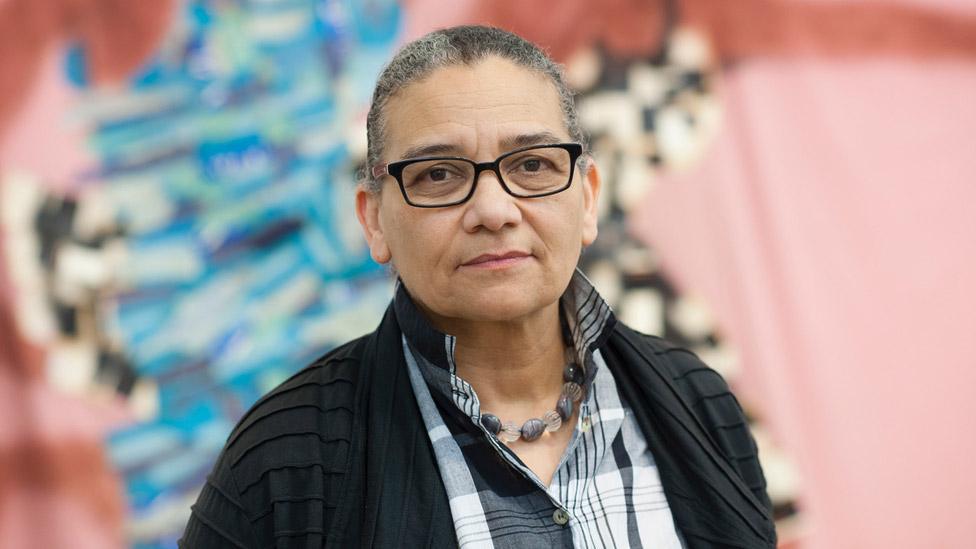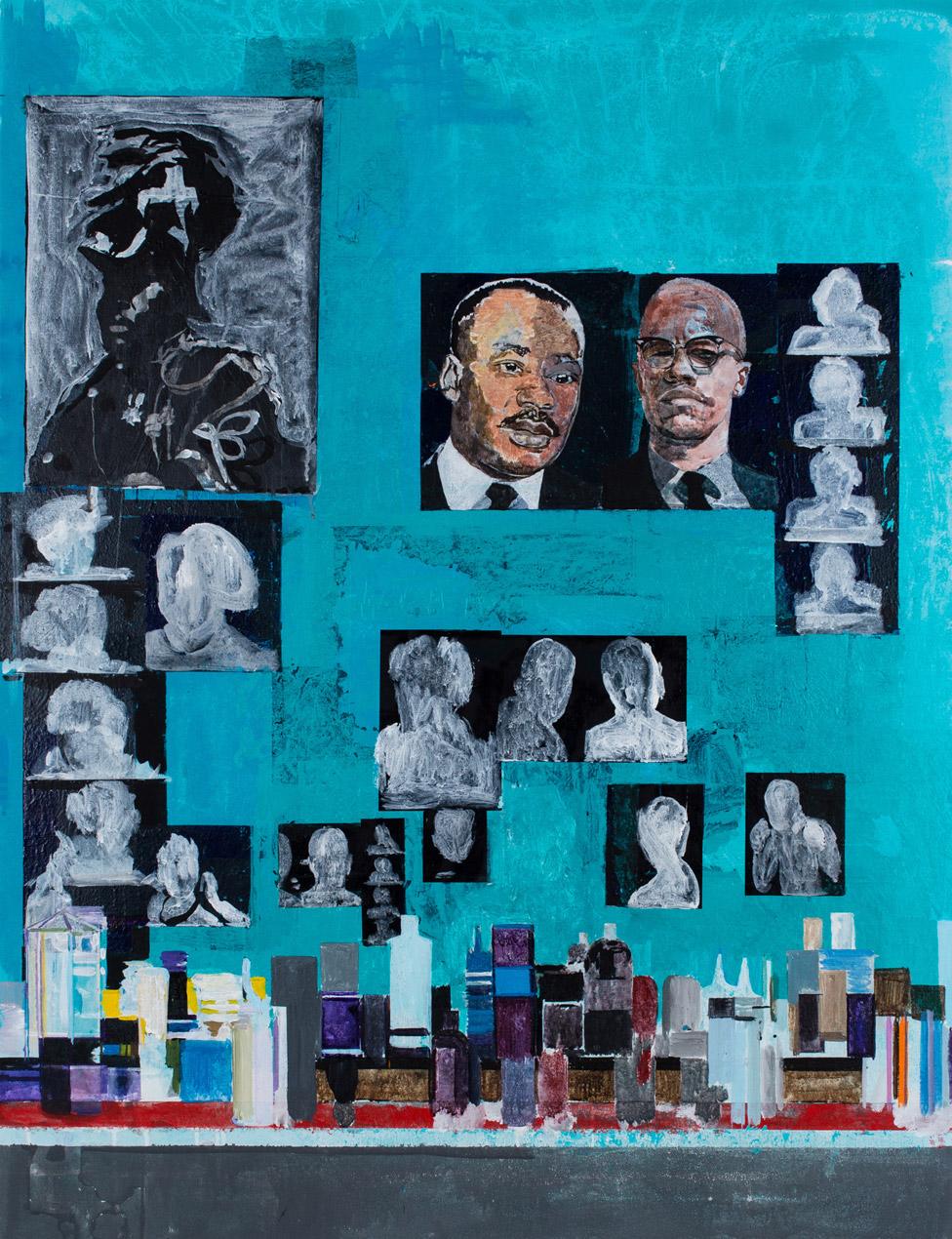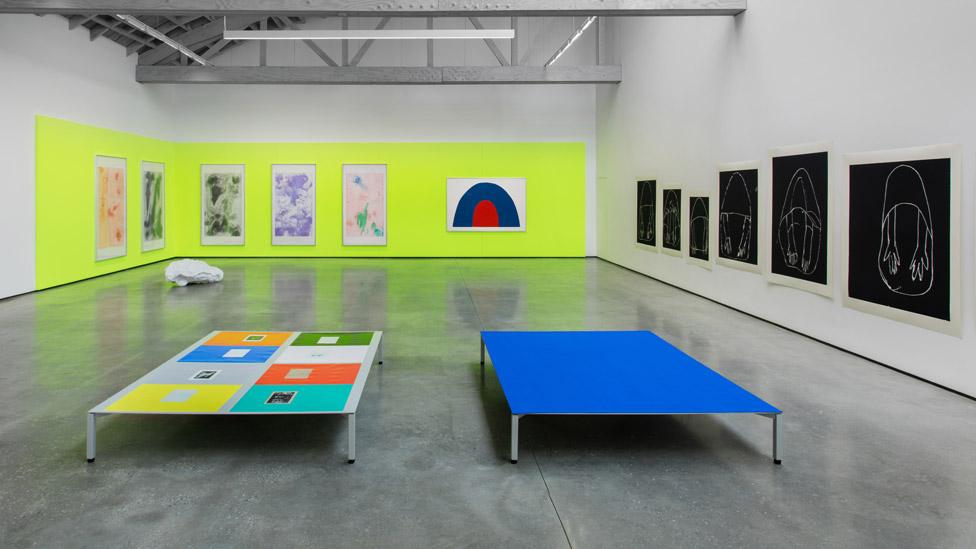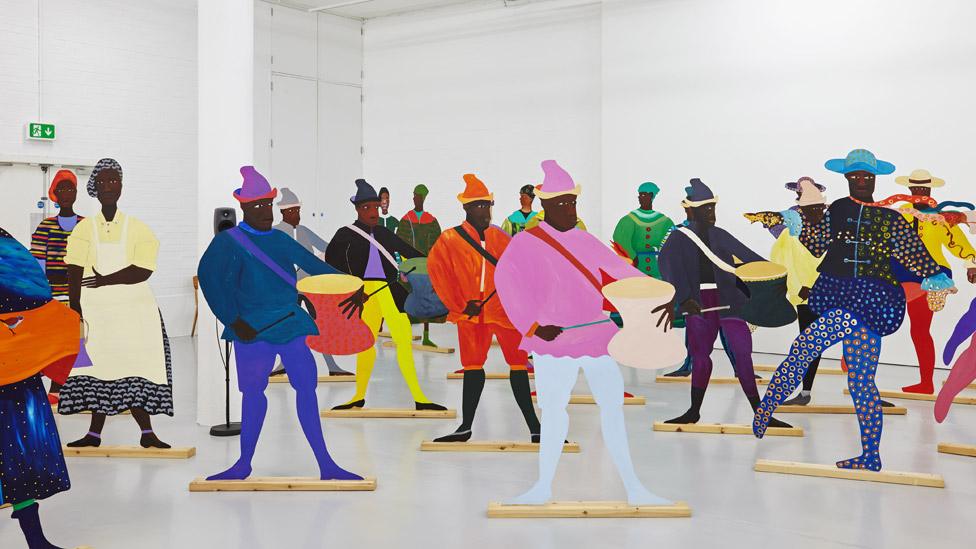Turner Prize: Black painting pioneers break award age barrier
- Published

Lubaina Himid was made an MBE in 2010
A 62-year-old veteran of Britain's black art scene, Lubaina Himid, is in the running for the Turner Prize after organisers scrapped its age limit.
British art's most high-profile award has abolished its ban on over-50s this year - meaning Himid is eligible.
At 52, Hurvin Anderson, another key black British artist, is among the other nominees for the £25,000 prize.
The multicultural shortlist is completed by German-born Andrea Buttner and Londoner Rosalind Nashashibi.
The prize was the domain of Young British Artists in the 1990s - but the youngest person on the Turner shortlist this year is Nashashibi at 43.
The winner will be announced at the Ferens gallery in Hull on 5 December.
The Turner Prize was founded in 1984 and was open to all ages until 1991, when organisers limited it to artists under 50.

Hurvin Anderson is nominated for exhibitions in Nottingham and Ontario
Analysis - BBC arts editor Will Gompertz
Lubaina Himid is likely to get the headlines, although probably not for her powerful, indignant images. It'll be her age that causes a stir. This is the first year the age restriction of 50 years old or under has been removed from the qualifying conditions for the prize.
She is not the only seasoned artist on the list. In fact, all of those shortlisted are comfortably middle-aged.
It is also the most international feeling list for this national prize. Each of the four artists has strong links with cultures and counties beyond the UK, which reflects the globalised nature of the art world and the real world.
Frankly, age and origin matter not a bit. What's important is whether or not they are any good, and do they - as the Turner Prize demands - represent developments in contemporary art? My answer would be firm "yes" to the former, and a more equivocal "not really" to the latter.
From a medium point of view, the list has a rather old-school feel about it, with two painters, a film-maker and a woodcutter - all of whom are making good work which I'm looking forward to seeing in what could be a memorable group show.
Find out more about the nominees:
Hurvin Anderson

One of Britain's leading contemporary painters, Anderson takes inspiration from his youth in Birmingham's African-Caribbean community and visits to Trinidad. Barber shops feature regularly - they are places where he says both cultures meet.
He's nominated for exhibitions in Nottingham and Ontario, Canada. The centrepiece of the Nottingham exhibition was a painting titled Is It Okay To Be Black? - a half-remembered view of a barber shop's wall featuring Martin Luther King and Malcolm X.
The Tate judges described him as "an outstanding British painter whose art speaks to our current political moment with questions about identity and belonging".
Andrea Buttner

Buttner's works have included a video of nuns who work in a funfair in Italy and woodcuts of faceless beggars.
She is interested in poverty, religion and shame. The judges said she highlights the "overlooked and undervalued", and were impressed with the wide range of media used - including "unfashionable" formats like woodcuts and glass painting.
Her materials range from plywood - for woodcuts featuring simple, lonely figures - to fabric from workers' uniforms and high-visibility jackets.
The jury also "noted Buttner's unique approach to collaboration and her exploration of religion, morality and ethics". The 45-year-old is based in London and Berlin, and is shortlisted for exhibitions in Switzerland and Los Angeles.
Lubaina Himid

Described by The Daily Telegraph, external as "the under-appreciated hero of black British art", Himid made her name in the 1980s as one of the leaders of the British black arts movement - both painting and curating exhibitions of similarly overlooked black female artists.
The Zanzibar-born, Preston-based artist is now professor of contemporary art at the University of Central Lancashire and was made an MBE in 2010.
She's nominated for solo shows in Bristol and Oxford. The Bristol show centred on larger-than-life cut-outs of 100 colourful figures - 17th Century African slave servants brought to Europe. Another work, Cotton.com, imagined conversations between the cotton workers of Lancashire and the slaves of South Carolina.
The Turner Prize judges praised her for "addressing pertinent questions of personal and political identity".
Rosalind Nashashibi

Fourteen years after she won the £24,000 Beck's Futures Prize, film artist and painter Nashashibi is nominated for the Turner.
Nashashibi was born in Croydon, south London, to Irish-Palestinian parents and studied at the Glasgow School of Art. She is nominated for an exhibition in California that included the film Electrical Gaza, which used live footage and animation to investigate everyday life in Gaza.
She's also nominated for her contribution to the Documenta 14 exhibition in Athens, including a film about mother-and-daughter artists in self-imposed exile in Guatemala.
The jury said they were impressed by the "depth and maturity" of her work, which "often examines sites of human occupation and the coded relationships that occur within those spaces".

The exhibition of work by this year's shortlisted artists runs at the Ferens gallery in Hull - the UK's City of Culture for 2017 - from 26 September to 7 January.

Follow us on Facebook, external, on Twitter @BBCNewsEnts, external, or on Instagram at bbcnewsents, external. If you have a story suggestion email entertainment.news@bbc.co.uk, external.
- Published6 December 2016
